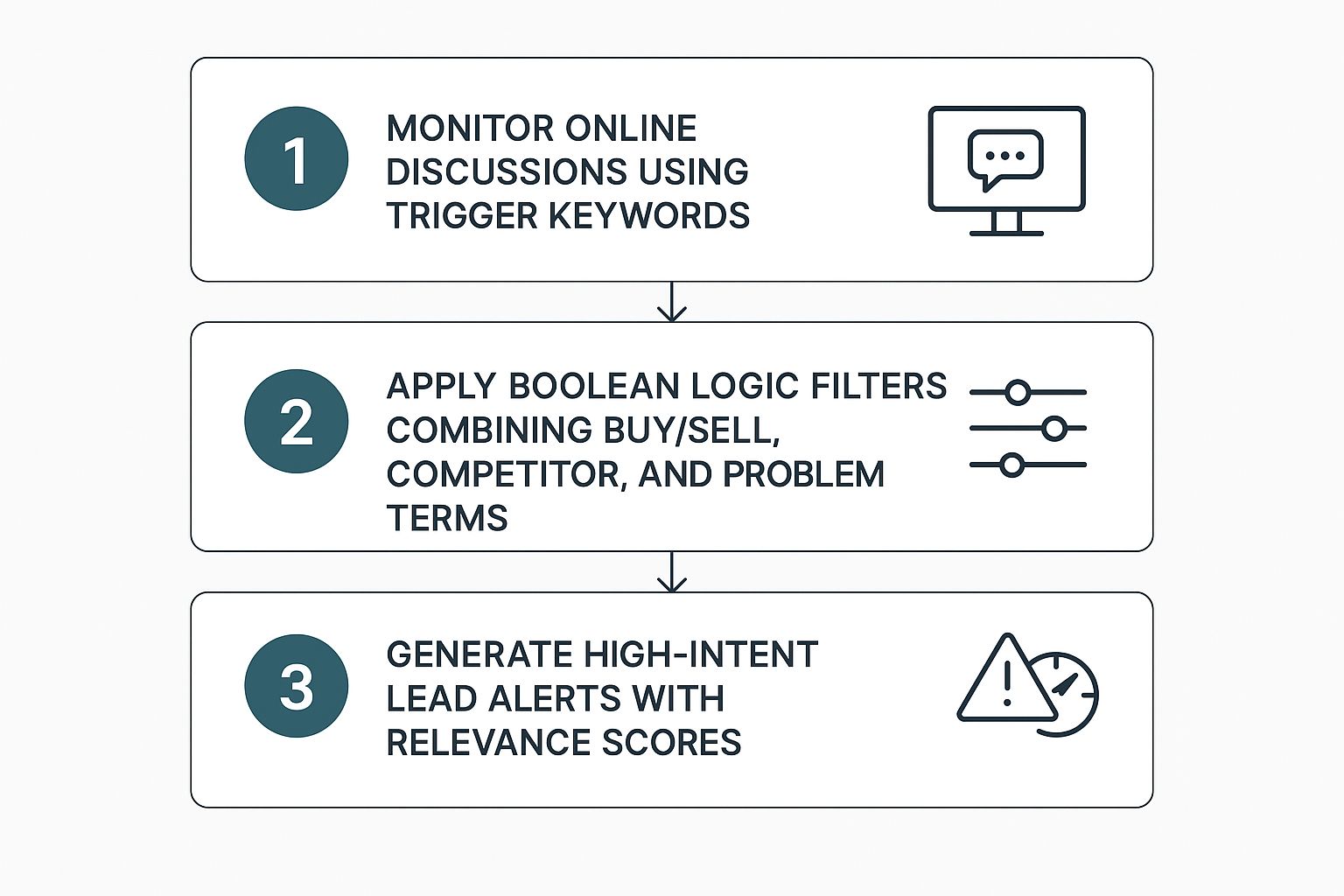
AI-powered lead generation is about using tech to find customers who are already looking for you. For me, as a founder, it’s about one thing: efficiency. Instead of you hunting for leads, the system automatically listens to online conversations for signals that someone is ready to buy. This means you jump into a discussion right when a potential customer is asking for help.
Why Traditional Outreach Is Broken

If you're a founder, your time is everything. The old way—scraping lists and blasting generic cold emails—is a massive time sink with a tiny ROI. It's a "push" approach: you interrupt people, hoping they care. It’s a numbers game, and frankly, it's broken.
The core issue? No context. Your cold email arrives out of the blue, disconnected from what your prospect is dealing with. To them, you’re just noise in their inbox, making a blind guess about their problems. This shotgun approach doesn't just waste your day; it burns your brand with every ignored email.
The Shift from Interrupting to Listening
People don't wait for your email. They’re on Reddit asking for recommendations, venting about a competitor's flaws, or searching for solutions in niche forums.
These are purchase intent signals, and they're everywhere. The winning move is to stop pushing and start "pulling" by joining these conversations as they happen.
This is where AI gives you an insane edge. Instead of guessing who might need your tool, you build a listening engine that finds these signals 24/7. You show up in the right place, at the right moment, with the exact answer someone is looking for.
"Stop interrupting what people are interested in and be what people are interested in. AI helps us find those moments of interest at scale, turning a cold outreach game into a warm conversation."
This flips the script. You’re no longer a random salesperson—you’re an expert with a helpful, timely solution. The results are clear. Businesses using AI for lead generation see revenue boosts of 3% to 15%, and sales ROI climbs by 10% to 20%. You can read more about these lead generation trends.
A Smarter Way to Find In-Market Buyers
This isn't theory; it's a practical way to find people actively looking to buy. By setting up a system to monitor discussions for specific keywords, pain points, or competitor mentions, you spot leads who have already raised their hands.
Instead of a stale contact list, you get a live feed of real opportunities, each packed with the context you need to start a real dialogue. The rest of this guide is our exact playbook for building this system.
Inside Our AI Lead Generation Engine
Theory is one thing, but a working system is another. At BillyBuzz, we built our business on this. This isn't a sales pitch—it's me, founder-to-founder, showing you exactly how our listening engine works to find high-intent leads.
Our entire system is a multi-layered filter that zeroes in on conversations where someone is actively talking about a need. We're not just scanning for broad chatter. We’re hunting for specific buying signals—the digital breadcrumbs that tell us someone is ready for a solution.
This approach moved us from guessing who might need our tool to engaging directly with people who have already raised their hands.
Building Our Keyword Triggers
The core of our engine is a curated set of keyword triggers. These aren't just single words. They're phrases and questions that signal different kinds of intent, broken down into three main categories.
Buy/Sell Signals: The most direct buying signals. We track phrases like "looking for a tool that..." or "any recommendations for..." or "what are you using for X?" These are gold because the person is literally asking for help.
Competitor Mentions: You have to watch your competitors. We set up alerts for phrases like "alternative to [Competitor A]" or "how does [Competitor B] compare to..." This gives you a lead who already understands your product category and might be unhappy with their current tool.
Problem-Based Searches: This is the most subtle but often most valuable category. People aren't naming a tool—they're just describing their pain. We track phrases like "how do I solve Y?" or "struggling with [problem our tool solves]". Jumping in here lets you be the helpful expert, not just another vendor.
Combining Filters With Boolean Logic
Keywords alone aren't enough. The magic is combining them with Boolean logic to create hyper-specific alerts. An effective AI powered lead generation system is about precision, not volume.
A broad filter like
"marketing automation"buries you in noise. But a specific filter like("alternative to Mailchimp" OR "HubSpot is too expensive") AND ("email marketing")serves up a handful of incredible leads.
Using operators like AND, OR, and NOT lets you tell the system exactly what conversation you want to find. It slashes false positives and saves you a ton of time.
This diagram shows our three-step process, from monitoring keywords to generating refined, high-intent lead alerts.

We cast a wide net for signals, then progressively narrow it down to a relevant stream of opportunities waiting for engagement.
Organizing our keyword filters into distinct categories helps us stay focused. Here’s a breakdown of how we structure our Boolean searches to find people ready to buy.
Our High-Intent Keyword Filter Examples
Here are the actual keyword categories and phrases we use to find buying signals.
| Signal Category | Our Actual Filters (Boolean Logic) | Why It Works |
|---|---|---|
| Purchase Intent | ("recommendation for" OR "looking for a tool" OR "what do you use for") AND ("social media scheduling") |
Catches users actively shopping for a solution in our niche. |
| Competitor Pain | ("alternative to Hootsuite" OR "Buffer is too simple") AND ("analytics" OR "reporting") |
Identifies users unhappy with a competitor's specific features. |
| Problem Aware | ("struggling with" OR "how do I automate") AND ("content approval workflow") |
Finds prospects describing a core pain point our product solves, even if they don't know our solution exists. |
By structuring our filters this way, every alert we get is a high-probability lead, not just noise.
Where We Focus Our Search
Keywords are half the battle; you have to point them at the right places. For B2B SaaS founders, certain online communities are goldmines. We focus where we know our ideal customers hang out.
Our primary hunting grounds are subreddits:
- r/saas: A hub for founders and marketers. Conversations are on-point, often about growth challenges and tool recommendations.
- r/marketing: Broader, but priceless for finding discussions about marketing tactics and the tools people use.
- r/growmybusiness: Great for finding early-stage founders hitting the exact walls our tool helps break through.
Aiming powerful filters at these specific communities creates an efficient lead generation machine. If you want to dive deeper, you might find this a comprehensive guide to AI-powered lead generation helpful. The secret is combining what to listen for with where to listen. That's how you stop chasing cold leads and start building a system that brings warm opportunities to you.
Crafting Outreach That Actually Connects

Finding a lead with a tuned AI-powered lead generation system is a win. But it's only half the battle. That first contact is where deals are made or lost. A generic, salesy message wastes all that hard work.
At BillyBuzz, our philosophy is simple: add value before you ask for anything. Your outreach shouldn't be a pitch. It should feel like a helpful expert joining a conversation at the right moment.
The goal is to become a trusted resource, not just another vendor. This takes empathy and an obsessive focus on their problem—not your feature list. After sending thousands of messages, we've learned this value-first approach is the only one that works.
The Psychology of a Great Response
Every template we use is built on a simple three-part framework designed to build trust and start a conversation.
- Acknowledge and Empathize: Show you actually read what they wrote. Mention their specific problem to prove you're not a bot. This builds instant rapport.
- Offer a Concise Solution: Give a brief, genuinely helpful tip or resource. This is crucial: the advice must have value on its own, even if they never check out your tool.
- Provide a No-Pressure Path Forward: End with a soft call-to-action. Frame your tool as one possible way to solve their problem at scale, but never demand a demo.
This structure respects their intelligence and positions you as a helpful guide.
Our Copy-and-Paste Outreach Templates
As a founder, I know how valuable ready-to-use assets are. Here are three of our go-to templates. Feel free to use them.
Template 1: Responding to a Direct "Tool Request"
Perfect for when someone posts, "Does anyone know a tool for X?"
Hey [Name], saw you were looking for a tool to help with [specific problem].
A lot of people solve this by [mention a common strategy or best practice]. It's a solid starting point.
Full disclosure, I'm the founder of a tool that automates this. If you want to see how we approach it, feel free to check us out at [Your Website]. No pressure, just thought it might be helpful!
Why it works: It offers free advice before mentioning the product. "Full disclosure" builds trust, and the CTA is low-friction.
Template 2: Responding to a "Problem Description"
Use this when someone describes a pain point your tool solves.
Ugh, dealing with [the specific pain point] is a headache. I remember struggling with that when we were trying to [achieve a related goal].
One thing that really helped us was implementing a [mention a specific process or methodology]. It reduced the manual work a lot.
We actually built a tool to handle that process automatically. If you’re curious, here’s how it works: [Your Website]. Hope the tip helps either way!
Why it works: It leads with pure empathy. The solution offered is a process, not a product, providing standalone value. The product is then positioned as the logical next step. Getting this right is key, and you can explore more strategies for personalized outreach with AI segmentation.
Template 3: Responding to a "Competitor Mention"
For when someone complains about a competitor or asks for alternatives.
Saw your comment about [Competitor's Name] and its issues with [specific feature/problem]. That can be frustrating when you're just trying to get [desired outcome] done.
While you're exploring options, you might find our approach to [the feature/problem] interesting. We focused on making it [mention 1-2 key differentiators, e.g., more intuitive, faster].
Here’s a quick link if you want to compare: [Your Website]. Good luck with the search!
Why it works: It validates their frustration without trashing the competitor, pivots immediately to your differentiators, and ends on a helpful note.
Building Your Automated Lead Funnel
You’ve figured out how to spot high-intent conversations and have a playbook for responding. Now, you need to turn that into a system.
As a founder, you can't spend all day manually checking alerts. The goal is a semi-automated engine that pipes qualified, context-rich leads directly to you or your team. This is the jump from a clever trick to a scalable process. The AI does the sifting, so you only see the conversations that matter.
At BillyBuzz, our workflow is built on this. Every mention gets automatically scanned and given a relevancy score. This single feature saves us hours of manual work every week.
Using Relevancy Scoring to Filter the Noise
Let’s be real: not all keyword mentions are equal. A random comment with your competitor’s name is a world away from someone asking for an alternative. Our AI gets that difference.
Our relevancy score analyzes context, sentiment, and phrasing to figure out intent. A score of 10 is a throwaway mention; a 95 means someone is practically waving their credit card.
This scoring is the heart of our automation. It lets us create rules so only the best leads ever get in front of a human.
Our Exact Alert Rule Setup
Once you have relevancy scores, you can build a powerful notification system. Inside BillyBuzz, our main alert rule is dead simple but ridiculously effective:
Instantly notify our #leads Slack channel for any mention with a relevancy score > 80%.
That one rule cuts out 90% of the noise. When a notification pops up, the team knows it's a hot lead that needs attention now. We don’t waste time debating low-quality mentions; the system has already vetted them. This is just one way you can learn how to find leads on social media with AI.
You can also create other rules:
- Competitor Alerts: Ping the product team for any mention of "alternative to [Competitor]" with a score over 70.
- Urgent Problem Alerts: Email the founder for any post with "urgent help" or "need a solution now" and a score above 85.
Rules like these turn your monitoring tool into a proactive lead-sourcing machine.
Integrating Your Tools for Full Automation
The final piece is plugging your monitoring system into your other tools. We use Zapier to connect BillyBuzz to our CRM.
Here’s our exact setup:
- Trigger: BillyBuzz finds a new mention with a relevancy score > 80.
- Action: Zapier instantly creates a new lead in our CRM.
- Data Mapping: The post content, a link to the conversation, and the username are all populated in the new CRM record.
By the time we see the Slack alert, there’s already a record in our CRM, ready for outreach. It's this efficiency that explains why companies using AI for lead generation report a 50% increase in quality leads while slashing costs by up to 60%. This automated funnel lets us scale outreach without scaling manual effort.
Focusing On Lead Quality Over Quantity

Ultimately, founders care about results. A thousand leads that don't convert are just busywork. An AI powered lead generation system built on social listening is different. It's not about stuffing your pipeline; it's about finding the few golden opportunities that turn into revenue.
A lead found this way isn't just a name on a list. They're a person who has already voiced a specific need.
That context changes everything. Your first outreach isn't an interruption—it's a timely, helpful conversation. You're not guessing their pain points; you're showing up with an answer to a problem they just mentioned.
The Power of Context-Rich Leads
At BillyBuzz, we see this daily. A lead from our AI monitoring system is already warm because it comes with built-in context. We know what problem they’re wrestling with, which competitor is failing them, or the exact features they need.
This means our outreach hits the nail on the head from the first sentence.
It’s a better experience for the prospect and a massive efficiency boost for us. Industry benchmarks show that AI-driven marketing automation can boost qualified leads by an incredible 451%. This happens because AI can create personal nurturing sequences that react to a lead's actions. You can read more on how AI spots buying signals here.
The magic isn't just finding the lead. It's understanding the 'why' behind their search. When you know what's motivating them, you can frame your solution as the perfect answer to their specific problem.
This is why we're obsessed with quality. A single, high-intent lead discovered by "listening" is worth more than a hundred names from a generic database. It’s a direct line to someone already looking for a fix.
How Warm Leads Transform Conversion Rates
When you're focused on quality, you have to know what makes a lead qualified. For us, a huge indicator is proven purchase intent—and our AI is great at spotting those signals. Our own data shows that leads from our monitoring system convert at a far higher rate than traditional outbound.
Anecdotally, our response rates for these warm leads are consistently 3-4x higher than our cold email efforts.
The sales cycle is also shorter. You skip the "let me explain what our company does" part and jump straight into solving their problem. Trust is already partially built.
For a lean team, that kind of efficiency is non-negotiable. You can't afford to burn time on outreach that goes nowhere. By focusing on high-quality, context-aware leads, you make sure every minute spent on sales is a minute well spent.
Getting Started Without Breaking The Bank
Jumping into a new AI tool shouldn't feel like a massive financial gamble. As a founder, I know every dollar counts. That's why we built BillyBuzz's pricing to grow with your business. This is a founder-to-founder chat about picking the right tool for the job you need done today.
Finding the Right Fit for Your Stage
Our plans are designed to match where you are on your journey.
The Starter Plan: For the solo founder or tiny team testing the waters. If you just want to track 5-10 essential keywords—your brand, your biggest competitor, your core service—this is your starting point. It automates basic listening without a hefty price tag.
The Growth Plan: Ready to bring on a sales rep or have a small marketing team? The Growth plan gives you more keywords and, crucially, the integrations you need to build a real process. You can pipe alerts into Slack or your CRM, turning random mentions into a structured funnel. This is where you shift from just playing around to building something repeatable.
Founder-to-founder advice: start with the smallest plan that covers your immediate needs. Prove the value to yourself first. Once the system is bringing in great leads and paying for itself, then think about upgrading.
When to Go All-In
Honestly, our top-tier plan isn't for most people starting out. It's for established companies with a full sales team that needs to track a universe of competitors, products, and industry chatter.
This is the level you need when you have multiple reps to feed. It’s the right move when your lead gen engine is already a core part of how you make money. But there’s no need to rush it. Start small, prove it works, and scale when the time is right.
Frequently Asked Questions
As a founder, I know that bringing in a new tool for lead generation raises practical questions. Here are the most common ones we hear.
How Much Time Does This System Actually Save?
It’s a game-changer. Compared to manually scrolling through Reddit or X, our team easily saves 8-10 hours every week. But the real win isn't just cutting out grunt work—it's the speed.
The system pushes high-intent opportunities to our Slack in real-time. We can engage with a prospect minutes after they’ve posted about a problem. That's something you could never do manually. Getting there first dramatically boosts your odds.
Is This Only for B2B SaaS Companies?
While it’s a natural fit for B2B SaaS, the strategy works for any business whose customers talk about their problems online before they buy.
We’ve seen this approach succeed for:
- High-end B2C products
- Service agencies (marketing, design, development)
- Consulting firms
The core idea is simple: find where your ideal customers hang out online. If they ask for advice before making a purchase, this system will work for you.
What's the Biggest Mistake Founders Make?
Hands down, setting keyword filters that are way too broad. It's tempting to track generic terms like "marketing" or "sales." The result? A firehose of noise that drowns out the actual opportunities.
The secret is to start with laser-focused, high-intent phrases. Think "alternative to [your competitor]" or "recommend a tool for [a specific pain point]." It is far better to get 5 highly qualified leads a week than to sift through 500 irrelevant mentions.
Start small and prove it works. Once you feel which phrases lead to real conversations, you can gradually broaden your search.
Ready to stop chasing leads and let high-intent opportunities come to you? BillyBuzz is the AI-powered listening engine built by founders, for founders. Start your free trial today and find your next customer.
